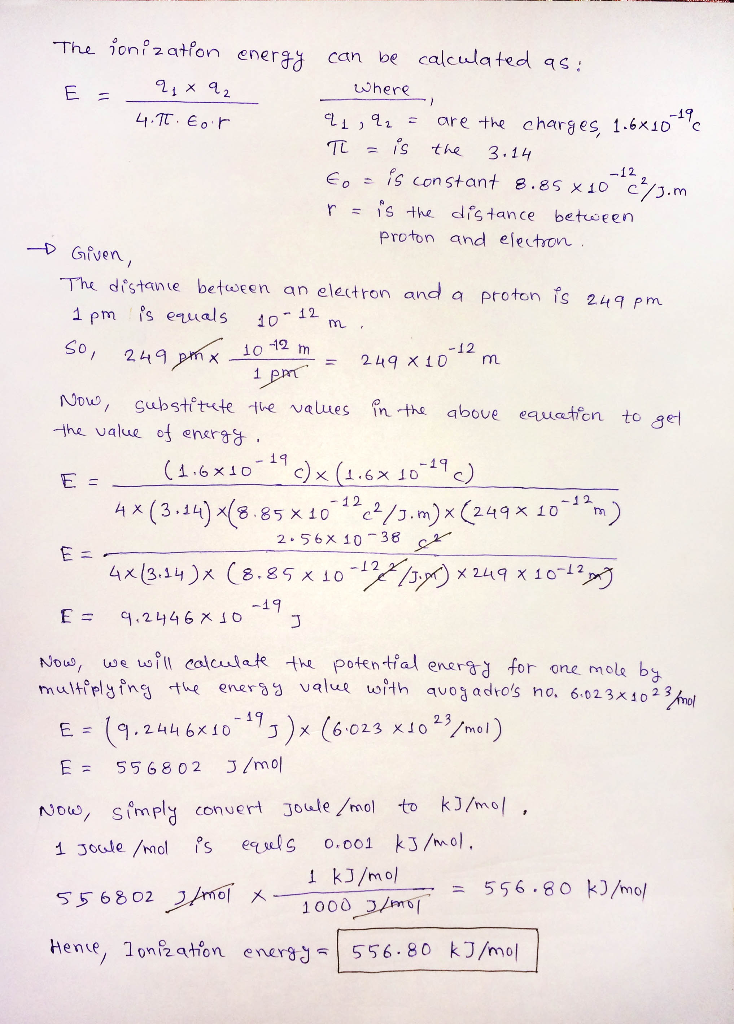Question
In: Chemistry
use coulombs law to calculate the ionization energy in kj mol^-1 of an atom composed of...
use coulombs law to calculate the ionization energy in kj mol^-1 of an atom composed of a proton and an electron separated by 249 pm.
E ionization =
the formula we have states (E coulomb approx equals q1q2/r12 ?
Solutions
Related Solutions
the ionization energy for a 1s electron in a silver atom is 2.462 x 106 kJ/mol...
the ionization energy for a 1s electron in a silver
atom is 2.462 x 106 kJ/mol
Determine an approximate value for Zeff for the Ag
1s electron. Assume the Bohr model applies to the
1s electron. Zeff is the apparent nuclear
charge experienced by the electrons
How does Zeff from part a compare to Z for Ag?
Rationalize the relative numbers.
The ionization energy of a certain element is 352 kJ/mol. (Ionization energy is the minimum energy...
The ionization energy of a certain element is 352 kJ/mol.
(Ionization energy is the minimum energy required to remove an
electron from an atom. It is usually expressed in units of kJ/mol;
that is, it is the energy in kilojoules required to remove one mole
of electrons from one mole of atoms.) However, when the atoms of
this element are in the first excited state, the ionization energy
is only 166 kJ/mol. Based on this information, calculate the
wavelength of...
The ionization energy of a cesium (Cs) atom is 596 kj/mol of atoms. What wavelength would...
The ionization energy of a cesium (Cs) atom is 596 kj/mol of
atoms. What wavelength would a single photon have
to have to ionize a single cesium atom?
ionization energy is usually expressed in units of kj/ mole 1000 j = 1 Kj use...
ionization energy is usually expressed in units of kj/ mole 1000
j = 1 Kj
use the bohr equation to calculate the ionization energy of
hydrogen in K j/ mole ? show your work
Ionization energy is the energy needed to eject an electron from an atom or ion. Calculate...
Ionization energy is the energy needed to eject an electron from
an atom or ion. Calculate the ionization energy, IE, of the
one-electron ion Be3 . The electron starts in the lowest energy
level, n=1.
The standard heat of formation of CaBr2 is -675 kJ/mol. The first ionization energy of Ca...
The standard heat of formation of CaBr2 is -675 kJ/mol. The
first ionization energy of Ca is 590 kJ/mol and its second
ionization energy is 1145 kJ/mol. The heat of sublimation of
Ca[Ca(s)→Ca(g)] is 178 kJ/mol. The bond energy of Br2 is 193
kJ/mol, the heat of vaporization of Br2(l) is 31 kJ/mol, and the
electron affinity of Br is -325 kJ/mol.
Calculate the lattice energy of CaBr2.
Calculate the total binding energy in kJ per mole nuclide and in kJ/mol nucleons for the...
Calculate the total binding energy in kJ per mole nuclide and in
kJ/mol nucleons for the following nuclides, using the data given
below.
Nuclide
Total binding energy
kJ/mol nuclide
kJ/mol nucleons
(a)
12 6 C
(b)
17 8 O
(c)
234 90 Th
Particle or atom
Mass (u)
proton
1.00728
neutron
1.00866
electron
0.00055
12 6 C
12.00000
17 8 O
16.99913
234 90 Th
234.04360
1 u = 1.66054×10-27
kg
1) The ionization energy of an atom is the energy required to remove an electron from...
1) The ionization energy of an atom is the energy
required to remove an electron from the atom in the gaseous
state.
Arrange the following elements in order of decreasing ionization
energy.
molybdenum
silver
germanium
phosphorus
strontium
2)
The metallic character of an element is defined as the
properties typical of a metal, especially the tendency to lose
electrons in chemical reactions.
Arrange the following elements in order of decreasing metallic
character.
F
Cr
P
Zn
Ca
Cs
S
Calculate the total ionization energy for the formation of C4+ from a gaseous C atom.
Calculate the total ionization energy for the formation of
C4+ from a gaseous C atom.
The successive ionization energies for an unknown element are IE1 = 896 kJ/mol IE2 =1752 kJ/mol...
The successive ionization energies for an unknown element are
IE1 = 896 kJ/mol IE2 =1752 kJ/mol IE3 =14,807 kJ/mol IE4 =17,948
kJ/mol To which family in the periodic table does the unknown
element most likely belong?
ADVERTISEMENT
ADVERTISEMENT
Latest Questions
- The world post Covid 19 has created the concept of social distancing which will impact on...
- Convert into pseudo-code for below code =============================================== class Main { public static void main(String args[])...
- If the density of the universe great than a critical value, then it might continue expanding...
- A 16.4-kg block rests on a horizontal table and is attached to one end of a...
- Freud’s theory of defense mechanisms has had a profound impact on the methods used by therapist,...
- discuss what a disclaimer is, when is it is issued, and how it would affect the...
- Explain why 1 additional net ATP is produced when the beginning substrate is glycogen compared to...
ADVERTISEMENT

 queen_honey_blossom answered 2 months ago
queen_honey_blossom answered 2 months ago